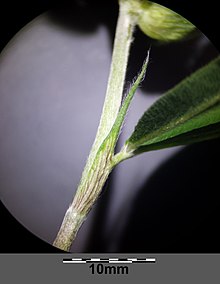Hill clover
| Hill clover | ||||||||||||
|---|---|---|---|---|---|---|---|---|---|---|---|---|

Hill clover ( Trifolium alpestre ) |
||||||||||||
| Systematics | ||||||||||||
|
||||||||||||
| Scientific name | ||||||||||||
| Trifolium alpestre | ||||||||||||
| L. |
The hill clover ( Trifolium alpestre ) is a plant species in the subfamily of the butterflies (Faboideae) within the legume family (Fabaceae). It belongs to the Alpestria subsection from the Trifolium section in the genus Klee ( Trifolium ). The hill clover is widespread from Europe to Asia Minor.
description
Vegetative characteristics
The hill clover grows as a perennial herbaceous plant and reaches heights of up to 40 centimeters. The stem is hairy close-fitting. The narrow, three-part leaves are up to 8 cm long, glabrous on the top and hairy on the underside.
Generative characteristics
The spherical to egg-shaped inflorescences are hardly stalked and surrounded by the uppermost leaves. The hermaphrodite flowers are five-fold and zygomorphic with a double flower envelope . The calyx has shaggy hair on the outside and is annoying. The crown is 10 to 15 mm long and has the typical shape of the butterfly flower .
Chromosome number
The number of chromosomes is 2n = 16.
ecology
The hibernating buds are close to the surface of the earth, so it is a hemicryptophyte . If the locations are not too shallow, the hill clover forms deep roots in order to get sufficient moisture.
Occurrence and endangerment
The area of the Hügel-Klee extends in almost all of Europe from the Pyrenees to central France, Lorraine, Eifel , Hanover, Denmark, Estonia, further to the Urals and to the Caucasus in the east; south to northern Greece and central Italy . For Europe there are documents from: Albania , Austria , Bulgaria , Czech Republic , Slovakia , Denmark , France , Germany , Greece, Hungary , Italy , Luxembourg , Poland , Romania , Switzerland , Turkey , former Yugoslavia . On the Asian continent , the hill clover occurs, for example, in Asia Minor : in Iran and Turkey.
The hill clover is absent in the Central European lowlands west of the Elbe ; it is very rare on its lower reaches and east of the Elbe; it is rare in the low mountain ranges and in Upper and Lower Austria , but there it often forms smaller populations; it is completely absent in the higher low mountain ranges of Central Europe; in the foothills of the Alps it is absent in larger areas; in the southern Alps it occurs scattered; overall it is rare in Central Europe .
In Central Europe , the hill clover prefers the colline to montane altitude range . It rises up to 1800 meters in the Alps and the maximum altitude is given as up to 2300 meters.
The hill clover thrives best on dry, base-rich, but low-lime loam - or loamy sand soils . He cannot stand nitrogen fertilization; it disappears on fertilized meadows.
The hill clover grows in bushes, light locations in dry forests, on dry meadows and in herb fringes. It is a type of character for the association: “Perennial fringes on woody plants” (Geranion sanguinei) ( plant sociology), especially for the Geranio-Trifolietum alpestris. But it also occurs in societies of the Potentillo-Quercion petraeae association.
This sub-oceanic half-light plant is a drought indicator, grows more frequently in low-nitrogen locations and is not salt-bearing.
The hill clover has lost many locations in Central Europe in the last few decades . The occurrence in Lower Saxony is endangered and in Mecklenburg-Western Pomerania . In Baden-Württemberg , the species is endangered in the Northern Gau landscapes, Southern Gau landscapes, Keuper-Lias-Land and on the Swabian Alb; the remaining occurrences are not endangered. All other occurrences in Germany are not endangered.
literature
- Margot Spohn, Marianne Golte-Bechtle: What is blooming there? Encyclopedia. Kosmosverlag, 2005
Individual evidence
- ^ Trifolium alpestre L., Hill-Clover. In: FloraWeb.de.
- ^ Trifolium alpestre at Tropicos.org. In: IPCN Chromosome Reports . Missouri Botanical Garden, St. Louis
- ↑ a b c d e f g h Dietmar Aichele, Heinz-Werner Schwegler: The flowering plants of Central Europe . 2nd Edition. tape 2 : Yew family to butterfly family . Franckh-Kosmos, Stuttgart 2000, ISBN 3-440-08048-X .
- ↑ a b Oskar Sebald, Siegmund Seybold, Georg Philippi (ed.): The fern and flowering plants of Baden-Württemberg. Volume 3: Special part (Spermatophyta, subclass Rosidae): Droseraceae to Fabaceae. Eugen Ulmer, Stuttgart 1992, ISBN 3-8001-3314-8 .
- ^ Erich Oberdorfer : Plant-sociological excursion flora for Germany and neighboring areas . With the collaboration of Angelika Schwabe and Theo Müller. 8th, heavily revised and expanded edition. Eugen Ulmer, Stuttgart (Hohenheim) 2001, ISBN 3-8001-3131-5 , pp. 596 .
Web links
- Hill clover. In: FloraWeb.de.
- Hill clover . In: BiolFlor, the database of biological-ecological characteristics of the flora of Germany.
- Trifolium alpestre L. In: Info Flora , the national data and information center for Swiss flora . Retrieved November 18, 2015.
- Distribution in the northern hemisphere according to Eric Hultén
- Profile and distribution map for Bavaria . In: Botanical Information Hub of Bavaria .
- Thomas Meyer: Data sheet with identification key and photos at Flora-de: Flora von Deutschland (old name of the website: Flowers in Swabia )
- Ecological indicator values for Trifolium alpestre .
- Günther Blaich: data sheet with photos.




